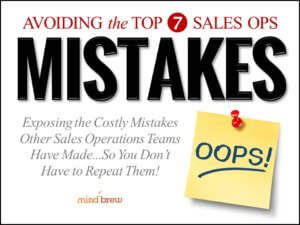We’ll often hear from SellingBrew Playbook subscribers who are in the process of executing a strategic initiative.
Sometimes, they’ve run into a snag and are looking for some advice as to how work through it…or around it, as the case may be. Others just want to share what they’ve done so far to make sure they’re on the right track and aren’t overlooking something important. And honestly, some folks just want to brag a little about the progress they’ve been making—and we’re always very happy to hear it!
But we occasionally hear from Sales Ops teams who haven’t yet been able to get their initiatives off the starting blocks.
In one recent example, the team wanted to invest in an analytical solution to help identify nascent customer retention and attrition issues before a lot of revenue had already been lost. It’s hard to imagine a more strategic initiative, right? Yet, all of their internal requests and proposals had been falling on deaf ears.
After a long conversation, we concluded that one contributing factor was that they were “selling” their initiative in the wrong way.
In essence, their internal proposals and requests were all saying, “Here’s the solution we want. Here’s what it will do and how it will work. It will take this long to implement and cost this much. And we expect a payback period of X and a 3-year ROI of Y. What say you?”
While this approach is pretty intuitive and may seem perfectly logical, it has a fatal flaw. When you lead with the solution like this, you’re basically assuming that everyone else fully understands the problem. And most likely, they do not. Not really. So for them, your proposed solution actually has very little context.
Simply put, it’s hard for others to properly evaluate “the answer” you’re providing when they don’t fully understand “the question.”
That’s why you should always start with the problem. Describe the problem in compelling detail. Explain why and how the problem has been occurring. Provide real-world examples to illustrate. Highlight what the problem has been costing the company in terms of money, time, reputation, competitiveness, market share, etc. Talk about the “duct tape” and “quick fixes” that have already been tried and explain why they’ve failed.
Once you’ve laid the proper foundations and provided the necessary context, then you can serve up the solution…with much better odds that others will agree with your conclusions.













